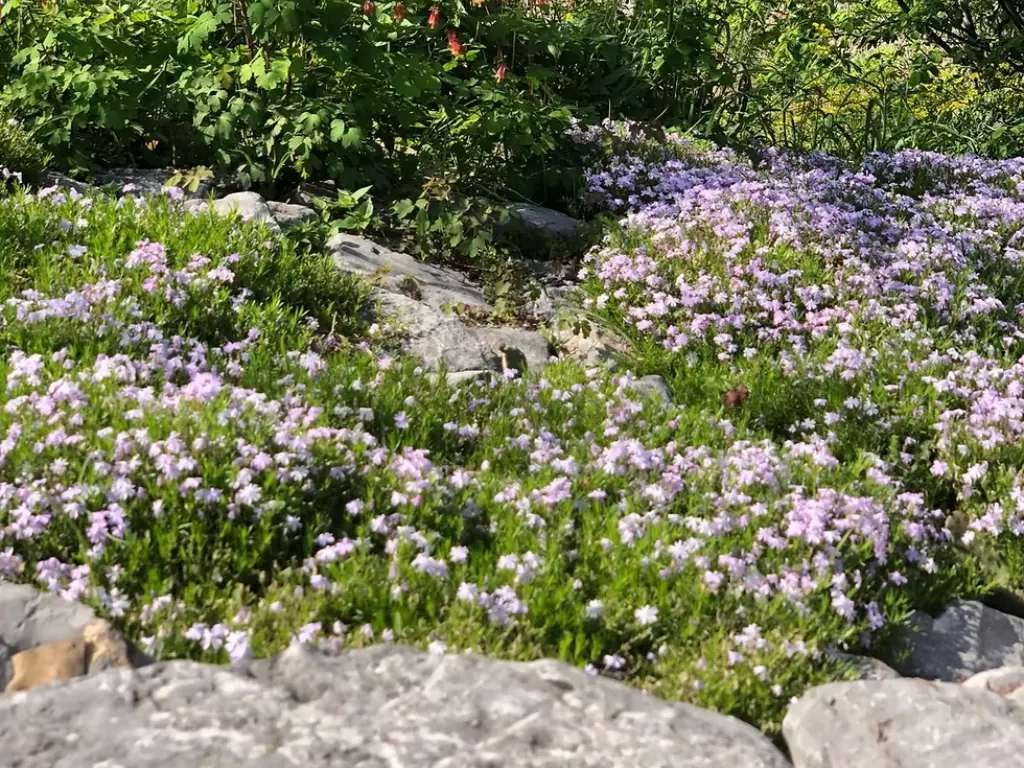Summer gardens are where magic meets sunlight — and if you’re looking for a plant that delivers charm, color, and resilience without asking for much in return, creeping phlox might just be the unsung hero your landscape needs.
You might know it for its spring blooms, but surprise: creeping phlox doesn’t stop impressing once spring ends. In fact, it continues to earn its spot in your garden all summer long — offering ground-hugging beauty, erosion control, pollinator support, and even foot traffic tolerance.
Here’s everything you need to know about growing and loving creeping phlox in the heat of summer. Grab your gloves, let’s dig in.
1. It’s Not Just a Spring Performer
Yes, creeping phlox (Phlox subulata) is famous for its breathtaking spring bloom — we’re talking rivers of pink, purple, and blue flowers cascading like confetti across garden beds and slopes.
But here’s the kicker: its dense, mossy foliage stays lush all summer long. Even after the blooms fade, creeping phlox continues to provide texture, color, and structure — like a beautiful green carpet that hugs your landscape.
Perfect for that “still looks good in August” vibe.
2. It Laughs in the Face of Heat
Worried about summer heatwaves? Don’t be. Creeping phlox is tough. Once established, it becomes extremely drought-tolerant and thrives in full sun conditions — perfect for those sunny borders, stone pathways, or sunbaked hillsides where other plants might throw in the trowel.
Just make sure the soil drains well — soggy roots are not its friend.
Pro Tip: Water deeply once a week (or less) in high heat. Shallow, frequent watering = weak roots.
3. Maintenance in Summer? Basically Zero

Unlike some summer bloomers that beg for deadheading, staking, or endless trimming, creeping phlox is the kind of low-maintenance beauty we all need in our lives.
Here’s your summer checklist:
-
Post-bloom trim in late spring? Great, helps maintain shape.
-
Mulch? Optional, but helps retain moisture.
-
Fertilizer Creeping Phlox? Maybe a light slow-release dose in early summer — but only if your soil is lacking.
-
Weeds? Not really an issue. Creeping phlox naturally smothers most intruders.
And if you forget all of that? No worries — it’ll probably be just fine.
4. Creeping Phlox Pairs Beautifully With Summer Favorites
Think of creeping phlox as the canvas, and your summer bloomers as the brushstrokes.
Try pairing it with:
-
Black-eyed Susans for contrast and vertical interest,
-
Lavender for that silvery summer elegance,
-
Coneflowers or salvia for a pollinator-friendly, color-packed border.
And don’t forget ornamental grasses — they add movement and texture while complementing the tidy sprawl of phlox.
Design Idea: Let creeping phlox spill over the edge of raised beds while taller perennials dance behind it — easy, breezy beauty.
5. It Holds Down the Fort (Literally)

If your summer garden includes slopes or areas prone to erosion, creeping phlox is your secret weapon.
Its shallow yet spreading roots form a natural ground net, locking soil in place and preventing runoff — even during sudden summer downpours. Plus, it stabilizes banks and rocky areas beautifully without looking “engineered.”
Want to reduce mowing on a tricky slope? Replace turf with phlox!
6. Still a Haven for Pollinators — Even Without the Blooms
You might think pollinators skip over creeping phlox in summer once the blooms are gone, but think again. While the biggest buzz happens in spring, phlox continues to support beneficial insects as shelter, landing pads, and thermal refuge from hot surfaces.
Consider it your garden’s quiet summer sanctuary for bees, butterflies, and even helpful beetles.
7. It Plays Well With Containers, Too
Surprised? Don’t be — creeping phlox does amazing in containers, especially shallow or wide planters. After blooming, the foliage drapes gently over the edge, softening hard lines and giving a “spilling-over” look that container gardeners love.
Pro tip: Use a wide bowl-style planter, pair with upright bloomers like dwarf zinnias or angelonia, and enjoy a living summer centerpiece.
8. Not All Creeping Phlox Are Created Equal
While all varieties share the same basic traits — low-growing, sun-loving, ground-hugging — some have distinct perks for summer:
-
‘Drummond’s Pink’ – bold color and reliable performance.
-
‘Emerald Blue’ – cool-toned elegance with delicate form.
-
‘Violet Pinwheels’ – richer purple, and slightly more vigorous spread.
-
‘North Hills’ – crisp white flowers, great for a clean summer look.
Final Thoughts
If you thought creeping phlox was only worth the hype in spring, think again. With heat tolerance, soil-holding power, low maintenance, and elegant summer texture, this perennial proves it’s more than just a pretty face.
Whether you’re planting a slope, designing a pollinator border, or just want something tough-but-beautiful, creeping phlox brings color and calm to your garden — even when the sun’s at full blast.
Ready to make your summer garden sing?
Have a gardening question? Drop us a note! Our team is always happy to help you turn your garden into a space you’ll love all season long.
Frequently Asked Questions
Q: Can creeping phlox grow in partial shade?
A: Yes — but with some caveats. While creeping phlox can tolerate a bit of afternoon shade, it really thrives in full sun. Aim for at least 6 hours of direct sunlight a day to get the lushest foliage and the most vibrant spring blooms. In too much shade, the plant may get leggy and sparse over time.
Q: How quickly does creeping phlox spread?
A: Creeping phlox spreads at a moderate pace. In its first year, it focuses on establishing strong roots with minimal spreading. By the second year, it begins to fill out noticeably, and by year three, a healthy plant can cover 12–24 inches in width. It forms a beautiful mat over time, but it’s never invasive — just steadily charming.
Q: What does creeping phlox look like when not in bloom?
A: When creeping phlox isn’t blooming, it still looks attractive — just in a quieter, more understated way. It forms a dense, low-growing mat of needle-like green foliage, often described as mossy or evergreen (especially in milder climates).
Q: Is creeping phlox invasive?
A: Not at all. It spreads slowly and steadily, forming a soft mat rather than taking over your garden. It’s what we’d call a “well-behaved groundcover.” You can easily manage its spread by trimming the edges or dividing the clumps if it starts to reach into other areas.
Q: How long does it take to establish?
A: Generally, creeping phlox needs one full growing season to get cozy in your garden. During the first year, you’ll see it settle in with modest growth. By year two, though, expect a fuller, more established mat — and bigger flower shows in spring. Patience pays off!
Q: Can I divide or move it?
A: Absolutely! Spring or just after blooming is the perfect time to dig up and divide clumps. Simply separate the roots into smaller chunks and replant them where you’d like more coverage. It’s a budget-friendly way to fill out bare spots or share with fellow gardeners.
Q: Will deer or rabbits munch on it?
A: Not likely. Creeping phlox is considered deer- and rabbit-resistant, which means they tend to pass it up in favor of tastier treats. It’s not immune to nibbling in desperate times, but for the most part, wildlife will leave it alone — another point in its favor!
Q: Can it handle foot traffic?
A: Light foot traffic is totally fine, especially between stepping stones or along garden paths. It’s a great “living grout” for pathways. That said, it’s not meant for high-traffic areas like a lawn. Use it in places where you can enjoy it visually without wearing it down too much.
Q: Does creeping phlox survive the winter?
A: Yes, and quite well! It’s a hardy perennial in USDA Zones 3–9. In colder regions, it may go semi-dormant or lose some color in winter, but the plant will bounce back beautifully in spring. In milder climates, the foliage often stays green year-round, providing winter groundcover and texture.
